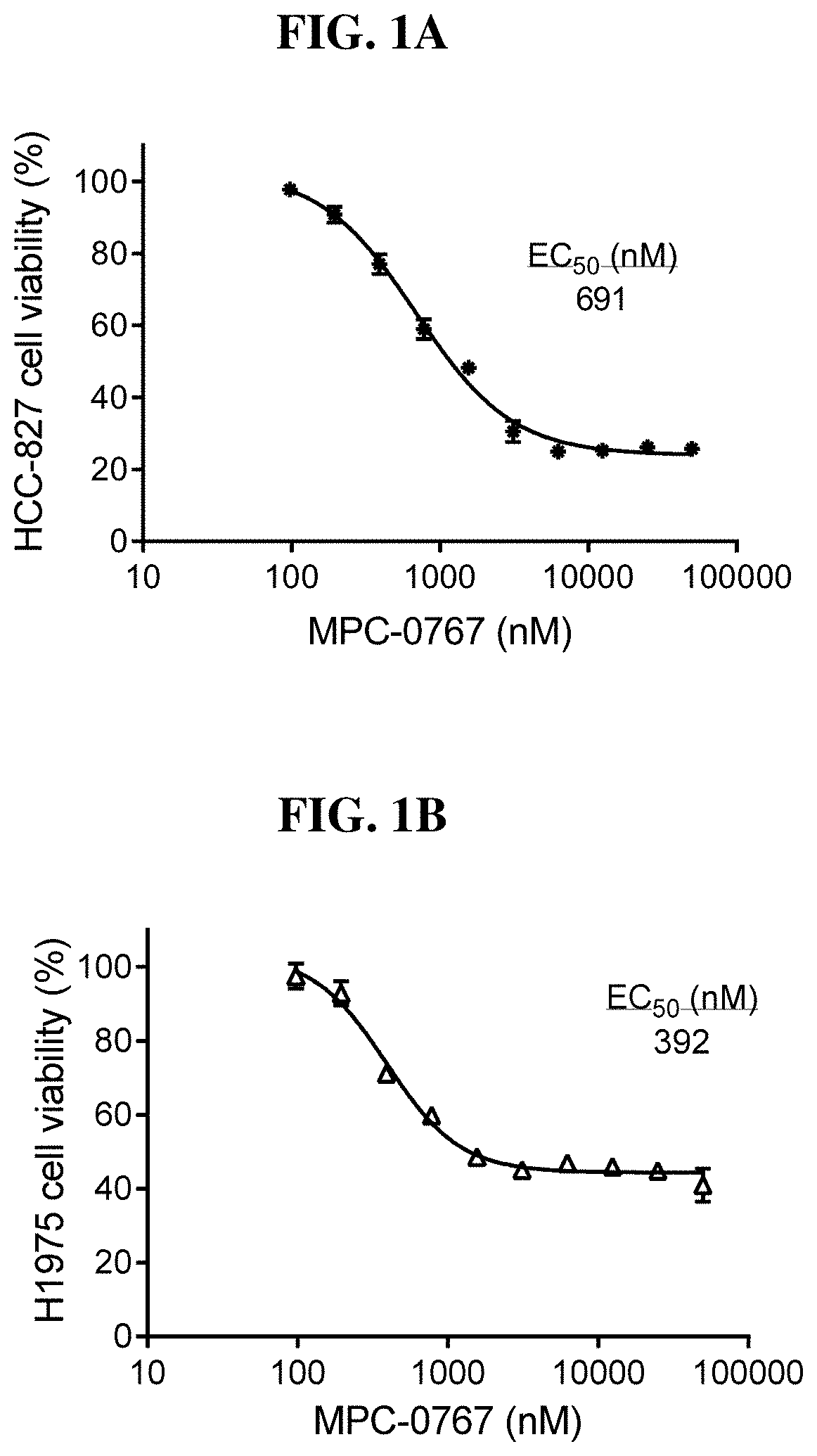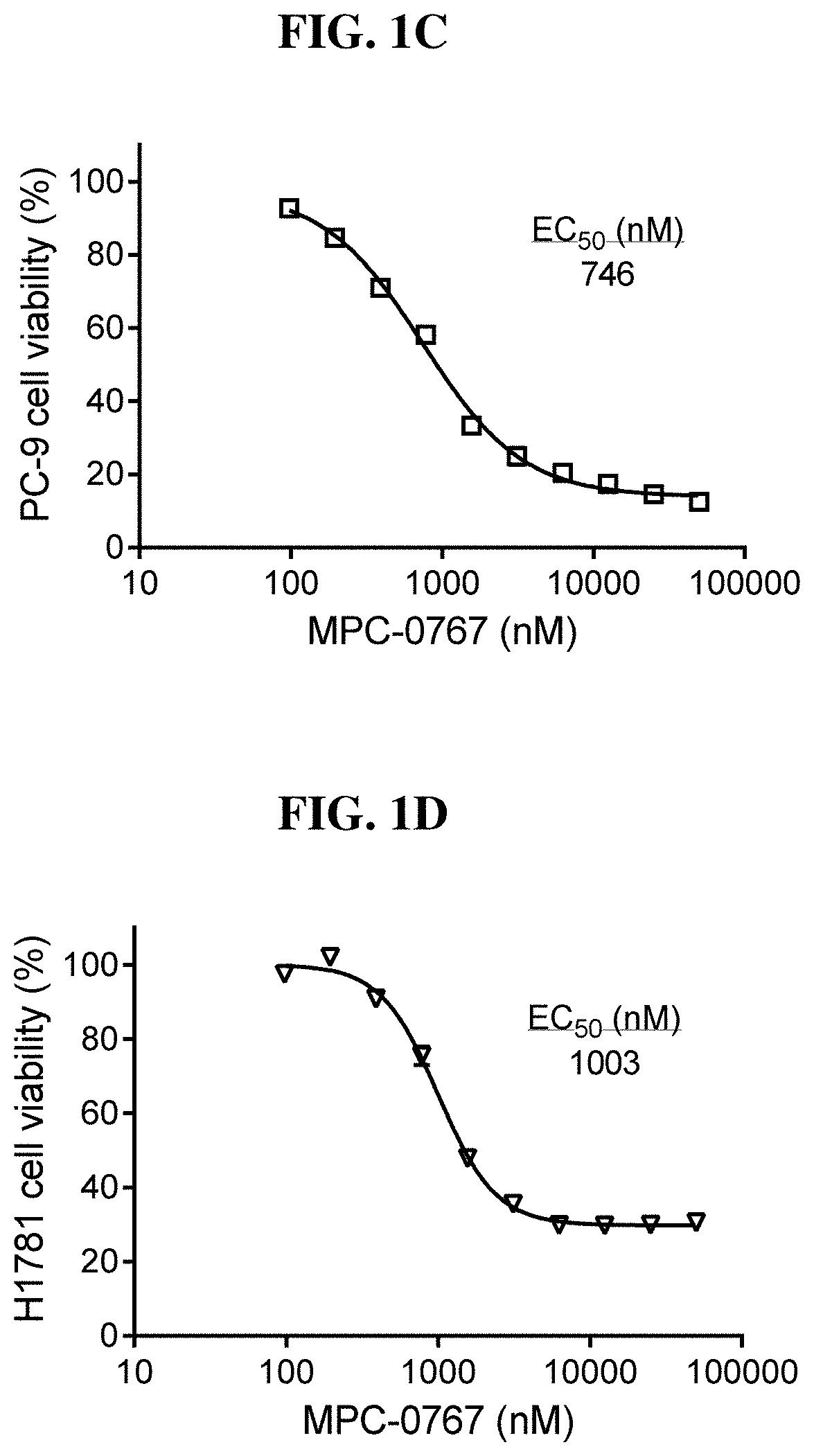Therapeutic methods relating to hsp90 inhibitors
a technology of hsp90 inhibitors and therapeutic methods, which is applied in the field of hsp90 inhibitors, can solve the problems of reduced proliferation and survival, limited activity, and degradation of potent client proteins, and achieves the effect of surprising combination effect and potent anti-cancer activity
- Summary
- Abstract
- Description
- Claims
- Application Information
AI Technical Summary
Benefits of technology
Problems solved by technology
Method used
Image
Examples
example 1
Inhibits Cell Viability in NSCLC Cell Lines Carrying Mutations in EGFR and HER2
[0220]The NSCLC cell lines HCC-827 (EGFR L858R), H1975 (EGFR L858R / T790M) PC-9 (EGFR Del E746_A750) and H1781 (HER2 G7776insV G / C) were treated with MPC-0767 at a concentration range of 98-50000 nM for 3 days, after which time cell viability was determined using CellTiter-Glo® reagent. FIG. 1 shows the dose-response curves of HCC-827 (FIG. 1A), H1975 (FIG. 1B), PC-9 (FIG. 1C) and H1781 (FIG. 1D) cell lines. All EC50 values were within clinically achievable concentrations.
[0221]To verify the mechanism of the loss of cell viability, H1975 cells were treated with MPC-0767 (0.7 μM) for 72 hours. After this time, cells were stained with 7-amino-actinomycin D (7-AAD) and annexin V, markers of cell membrane integrity and of apoptosis, respectively. As shown in FIG. 2, treatment of H1975 cells with MPC-0767 (0.7 μM) resulted in a decrease in the percentage of viable cells (7-AAD negative and annexin V negative) a...
example 2
Displays Potent Anti-Leukemic Activity in AML Cells Harboring FLT3-ITD
[0226]Exponentially growing cell lines were counted and seeded into 96-well clear, flat-bottomed polystyrene microtiter plates in a final volume of 90 μL per well. For primary AML samples, cells were seeded into 384 well plates at a density of 2×104 cells in a final volume of 27 μL per well. To treat cell lines or primary samples 10 μL or 3 μL, respectively, of 10× concentrations of MPC-0767, were then added to the cells to give a final concentration of 10000 nM, 5000 nM, 2500 nM, 1250 nM, 625 nM, 313 nM, 156 nM, 78 nM, 39 and 20 nM. For comparison, cells were treated with the FLT3 inhibitor gilteritinib (of 100 nM, 50 nM, 25 nM, 12.5 nM, 6.3 nM, 3.1 nM, 1.6 nM, 0.8 nM, 0.4 and 0.2 nM). Cells were seeded and treated in duplicate. After incubation for three days, cell viability was determined by measuring intracellular ATP levels using the CellTiter-Glo® assay system by adding to each well either 100 μL for 96 well...
example 3
is Cytotoxic in Primary AML Cells Harboring FLT3-ITD
[0229]To test whether the anti-leukemic effect of MPC-0767 is due to induction of cell death, 4 primary AML samples (all harboring FLT3-ITD) were treated with increasing concentrations of MPC-0767 for 72 hours. Samples were then processed for quantification by flow cytometry of cells positive for annexin V and 7AAD. These markers allow the detection of cell death, specifically dead (7AAD only positive), early apoptotic (annexin V only positive) or late stage apoptotic / necrotic (7AAD and annexin V positive) populations were combined to give a readout of cell death.
[0230]As shown in FIG. 6, primary AML samples treated with MPC-0767 show a dose-dependent increase in cell death. Of note, one of the samples (Y1265) was obtained from a patient who relapsed on gilteritinib.
[0231]These findings demonstrate that MPC-0767 induces cell death, through the induction of apoptosis, in primary AML samples that harbor FLT3-ITD. Moreover, MPC-0767 i...
PUM
| Property | Measurement | Unit |
|---|---|---|
| survival time | aaaaa | aaaaa |
| volume | aaaaa | aaaaa |
| volume | aaaaa | aaaaa |
Abstract
Description
Claims
Application Information
 Login to View More
Login to View More - R&D
- Intellectual Property
- Life Sciences
- Materials
- Tech Scout
- Unparalleled Data Quality
- Higher Quality Content
- 60% Fewer Hallucinations
Browse by: Latest US Patents, China's latest patents, Technical Efficacy Thesaurus, Application Domain, Technology Topic, Popular Technical Reports.
© 2025 PatSnap. All rights reserved.Legal|Privacy policy|Modern Slavery Act Transparency Statement|Sitemap|About US| Contact US: help@patsnap.com



